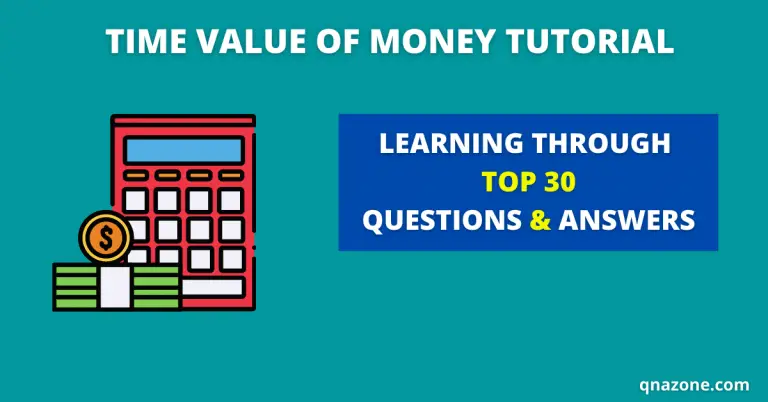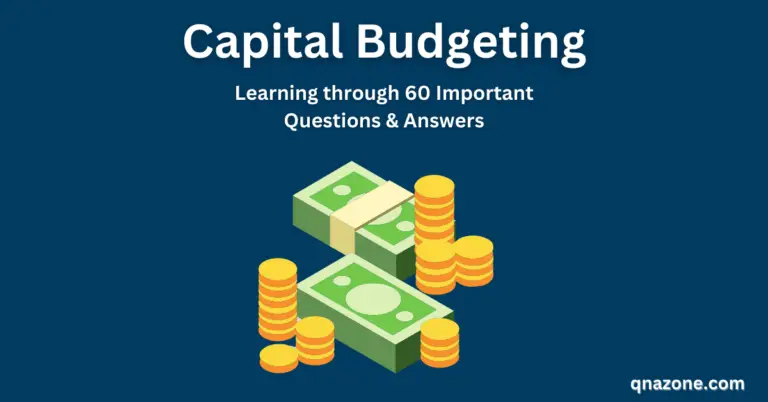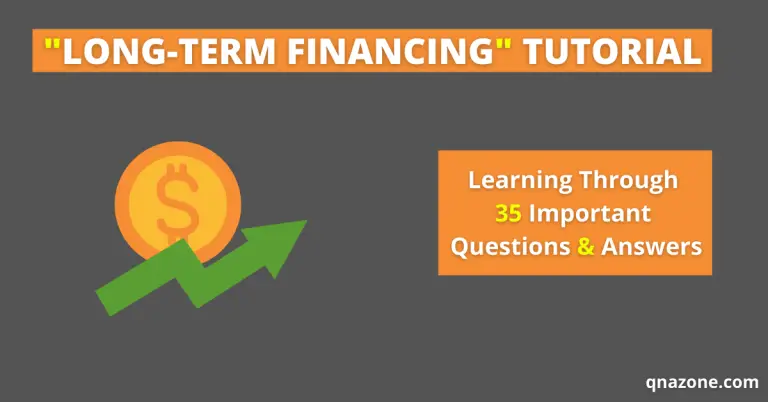35 Important Cost of Capital Questions and Answers [With PDF]
The 5th chapter of our Finance learning course is “Cost of Capital”. In this article, we’ll learn the 35 most important cost of capital questions and their answers.
It will help you understand the important cost of capital terms and their explanations quickly.
By reading this post, you may quickly prepare for Finance courses and for any competitive tests such as school and college exams, vivas, job interviews, and so on.
So let’s get started…
Cost of Capital Questions and Answers
The 35 important cost of capital questions and answers are as follows:
Question 01: What is the Cost of Capital?
Answer: The cost of capital is the rate of return on investment that a company must earn in order to maintain the market value of its stock.
Question 02: What is the Importance of Cost of Capital?
Answer: The importance of the cost of capital is as follows:
- Evaluation of investment project
- Determine the best capital structure.
- Choosing a source of funding
- Establish a dividend policy
- Demonstrate the financial efficiency of high-ranking officials.
- Establish a debt policy
Question 03: What is the Limitation of Determining the Cost of Capital?
Answer: The main limitation of determining the cost of capital is as follows:
- When the price level fluctuates, determining the cost of capital becomes difficult.
- If future dividends are miscalculated, determining the actual cost of capital becomes difficult.
- Inflation is not considered in determining the cost of capital. In order to determine the cost of capital for a business organization, inflation should be taken into account.
- The discount rate that is taken in determining the capital cost of ordinary shares is taken by incorrect correction. As a result, it is not calculated correctly.
- Depreciation is not considered in determining the cost of capital. As a result, the actual cost of capital is not determined.
Question 04: What are the Four Long Term Sources of Fund?
Answer: The four long term sources of funds are as follows:
- Long term loan capital
- Priority share capital
- General share capital
- Reserved Income
Question 05: What are the Components of the Cost of Capital?
Answer: The four components of cost of capital are as follows:
- Cost of debt/bond
- Cost of preferred stock
- Cost of Common stock
- Cost of retained earnings
Question 06: What is the Cost of Debt Capital?
Answer: The business organization takes loans to earn extra income. The cost of debt capital refers to the cost of borrowing money.
Question 07: What are the Two Types of Bonds?
Answer: The two types of bonds are as follows:
- Redeemable bonds and
- Irredeemable bonds
Question 08: What is an Irredeemable Bond?
Answer: Debts that do not have a specific repayment period are called irredeemable bonds. The owners of these bonds receive interest at a fixed rate for as long as the company operates.
Question 09: What is the Formula for Calculating the Cost of Irredeemable Debt?
Answer: The formula is as follows:
Before Tax Cost of Debt:
Kd = I/NSV
After Tax Cost of Debt:
Kd = I/NSV (1-t)
Here,
Kd = Cost of Debt
I = Amount of Interest
NSV = Net Sales Value
T = Corporate Tax Rate
Question 10: What is a Redeemable Bond?
Answer: A redeemable bond is a bond that is repaid to its owner or investor at the end of a specified period.
Question 11: How to Calculate the Cost of Redeemable Bond?
Answer: The formula for calculating the cost of the redeemable bond is as follows:
Kd = [{I(I-T)+(RV-NSV)/N}/(RV+NSV)/2]
Here,
Kd = Cost of Debt
I = Amount of Interest
NSV = Net Sales Value
T = Corporate Tax Rate
RV = Redemption Value
Question 12: What is Floating Cost?
Answer: A company’s floating cost is the cost of issuing and selling financial assets. The cost of capital rises as a result of rising floating costs.
Question 13: How to Calculate The Tax-Adjusted Cost of Loan Capital?
Answer: Assume, the businessmen’s 15% pre-tax cost of loan capital is adjusted by a 25% interest rate, the tax-adjusted cost of loan capital is as follows:
Tax-adjusted cost of loan capital = 15% x (1-25%)
= 11.25%
Question 14: How to Calculate the Cost of Priority Share?
Answer: We know that,
Cost of priority share = Expected dividend of shareholders /Money got from the sale of shares x 100
Example: Assume, A company is thinking about selling 10% priority shares with a $1,000 face value. Each share is expected to bring in $800 for the company. Using the information provided, the cost of those shares can be calculated as follows:
Cost of priority share = (1,000*10%)/800
= 12.50 %
Question 15: What is the Main Difference between Loan capital and Priority Shares Capital?
Answer: The main difference between loan capital and priority share capital is that loan capital providers typically receive interest for specific terms. Priority shareholders, on the other hand, receive dividends at a fixed rate for an indefinite period of time.
Question 16: What are The Two Methods of Determining the Cost of General Capital?
Answer: The two methods of determining the cost of general capital are as follows:
- Zero dividend increase method
- Dividend increase in fixed-rate method
Question 17: How to Calculate the Cost of General Capital Using the Zero Dividend Increase Method?
Answer:
For example, if a company gives a $10 dividend per share, it is supposed that the company will give a $10 dividend to the shareholders in future years also.
In this method, if the dividend per share is divided by the market price of the share, we get the cost of general shares. It is shown in the formula the following:
Cost of general share capital = Dividend 1 /Share price0
Here, Dividend1 = Expected dividend at the end of the year
Share price0 = Present market price of shares
Example: The present market price of a share of a company is $120. The company has announced a $10 dividend per share this year. The cost of the general share capital of the company can be calculated in the following way:
Cost of general share capital = 10/120
= 8.33 %
Question 18: How to Calculate Cost of General Share Capital Using Dividend Increase in Fixed Rate Method?
Answer: Here, it is supposed that a company does not give an equal amount of dividend every year. However, this method has some inferred conditions.
It is supposed in these conditions, the company’s dividend will increase every year and the rate of this increase will remain the same every year.
For example, if any company announces a $10 dividend in the current year and the inferred dividend increase rate is 10%, then –
After 1 year, the expected dividend will be 10 (1 + 0.10) = $11
After 2 years, the expected dividend will be 11 (1 + 0.10) = $12.1
After 3 years, the expected dividend will be 12.1 (1 + 0.10) = $13.31
In this way, every year expected dividend is increased by 10%.
Cost of general share capital can be calculated by applying dividend increase in fixed-rate method, with the use of formula, in the following way:
Cost of general share capital = Dividend 1 /Share price0 + Rate of increase
Here, Dividend1 = Dividend0 (1 + Rate of increase)
Dividend0 = Dividend of this year
Share price0 = Present market price of shares
Rate of increase = Rate of increase of dividend
Example: A company wants to determine the cost of general share capital. The present market price of the share of the company is $200. The company gave a $20 dividend per share in the year just ended. By analyzing previous records, it is found that the company’s dividend increases by 6% every year. The following method could be used to calculate the cost of general share capital:
Cost of general share capital = {Dividend1 /Share price + Rate of increase} x 100
= {20(1 + .06)/200 + .06} x 100
= 16.6%
Question 19: What are the Problems in Determining the Cost of General Capital?
Answer: The problems in determining the cost of general capital are as follows:
Determining future expected dividends is a complex task, as the rate of dividend does not remain fixed like that of priority shares.
To guess the future income of a company and the rate of dividend increase is another complex task.
Question 20: How to Calculate The Average Cost of Capital?
Answer:
Assume, a company has 5000 million general share capital, 3000 million loan capital, and 2000 million priority share capital.
The rate of interest on loan capital is 10% and the rate of dividend in priority shares is 9%.
The market price of general shares and priority shares are $270 and $120 respectively. The company has given a dividend of $15 per share to the shareholders this year and the dividend has increased by 5% from the rate the company gave earlier.
If the tax rate is 30%, what is the average cost of capital for the company?
Solution:
Cost of loan capital = 10% x (1 – Tax rate) = 10% x .7 = 7%
Cost of priority shares = (Dividend per share ÷ Market price of share)
= 9 ÷ 120 = 7.5%
Cost of general shares = 15(1 + .05)/270 + .05 = 10.83%
Now, we are to find out what portion of the total capital of the company is each source of capital. Based on the information provided, it is clear that in the total capital,
Portion of general shares is (5,000/10,000) or 50%,
A portion of loan capital is (3,000/10.000) or 30% and
A portion of priority shares is (2,000/10,000) or 20%.
The average cost of capital of the company will be calculated by multiplying the cost of each source by the relevant percentage of these three and then doing the total of these multiplications.
That is, average cost of capital = (10.83 x .5) + (7 x .3) + (7.5 x .2) = 9.02%
Question 21: How Does Inflation Influence the Cost of Capital?
Answer: Inflation indirectly affects a company’s cost of capital. This is because the purchasing power of money decreases during inflation and the money supply in the market increases and the interest rate also increases. As a result, the cost of capital also changes.
Question 22: Why Cost of New Common Stock is Higher than the Cost of Retained Earnings?
Answer: The cost of financing the issuance of the common stock exceeds the cost of retained earnings.
This is due to the fact that when issuing new shares, you must incur a variety of expenses (sales-related expenses), but you do not have to incur any flotation costs when raising funds through retained earnings.
As a result, the cost of new ordinary shares is higher than the cost of retained earnings.
Question 23: What is the Weighted Average Cost of Capital (WACC)?
Answer: The weighted average cost of capital (WACC) is the rate of return that must be earned on assets in order to provide an expected return to all suppliers of funds equal to what they could expect from the alternate investment of equal risk.
Question 24: What is the Cost of Retained Earnings?
Answer: Although retained earnings are kept by the firm, they belong to the common stockholders. By permitting a firm to retain earnings, common stockholders incur an opportunity cost because they give up cash dividends.
They expect the firm to earn the same rate of return on the retained earnings as it provides on common stock. That means the component of the cost of retained earnings is equal to the rate of return on common stock.
Question 25: What are the Assumptions about the Cost of Capital?
Answer: The important assumptions of cost of capital are as follows:
- Business and financial risks are assumed to be unchanged.
- After-tax costs are considered relevant.
- Short-term loans will not be included in the capital structure.
- The divined policy is stable.
- The capital structure of the firm will be unchanged.
Question 26: What are the Four Steps of Calculating Weighted Average Cost of Capital (WACC)?
Answer: The following are the four steps in calculating the weighted average cost of capital (WACC):
- The cost of each source of capital has to be determined separately.
- The ratio or weight of each source has to be determined in the capital structure.
- The cost of capital and the ratio of capital have to be multiplied together in different ways.
- Each source and the capital ratio have to be multiplied and added together.
After performing the above four tasks, the weighted average cost of capital (WACC) can be determined
Question 27: Why is a Loan a Lower-cost Source of Funding?
Answer: The following are the reasons why a loan is the lower-cost source of funding:
- Loan interest is deductible as a taxable benefit. As a result, the loan’s interest rate is lower.
- The loan will pay a fixed rate of interest on the fund. As a result, investors are assured of a profit. As a result, the cost of debt capital is typically lower.
- Loan funds must be repaid within the time frame specified. As a result, loan interest rates are lower.
Question 28: What is the Effect of Flotation Cost on Cost of Capital?
Answer: The flotation cost refers to the cost of selling shares or debentures. Flotation costs are typically incurred when new share bonds are sold.
If no floatation cost exists, the shares and debentures are sold at the written price. That is, the selling and written prices will be the same.
The floatation cost raises the price of shares or debentures. For flotation costs, the three types of capital listed below are used.
- Ordinary shares,
- Preferred shares, and
- Bonds.
Question 29: “Equity Capital is Cost-Free”-Do You Agree?
Answer: Equity capital is the combination of share capital and retained earnings. Some people think that equity capital is cost-free.
According to them, firms are not compelled to pay a dividend on the common stock capital. If the company makes enough money, it will pay out dividends. That is why they claim that the equity capital is free of charge.
The firm must bear floatation costs when issuing new common stock. Furthermore, common stockholders receive dividends at the end of the fiscal year.
As a result, the floatation cost and dividend are the cost of common stock.
Question 30: What is Historical Cost?
Answer: The cost that occurred in the past for the purpose of collecting funds for any project is referred to as historical cost. In reality, this type of cost is used to approve future project costs.
Question 31: What is Explicit or Direct Cost?
Answer: The cost that is paid directly to collect capital for the unavoidable project is referred to as the explicit cost or direct cost.
Question 32: What is Implicit Cost?
Answer: It is the rate of return associated with the best investment opportunity for the firm and its stockholders that would be foregone if the projects presently under consideration by the firm were accepted.
For accepting a return from the best opportunity, we are foregoing another possible profitable opportunity. As a result, a cost arises that calls implicit cost.
Question 33: What is Future Cost?
Answer: It is the estimated cost of any project used to make investment decisions. The future cost would be incurred if the firm raised capital from each source now or in the near future.
Question 34: What is Overall Cost?
Answer: The total cost of all specific sources of capital is referred to as the overall cost or average cost. To obtain the average cost of capital, the component of costs is combined based on the weight of each component of capital. As a result, the total cost is also known as the weighted average cost of capital (WACC).
Question 35: What is Opportunity Cost?
Answer: The opportunity cost is the rate of return that a company must forego when choosing one use of funds over another.
I hope that by the end of this post, you have a good understanding of the “Cost of Capital” chapter.
You will gain a better understanding of the “Cost of Capital” chapter if you read this 35 important cost of capital questions and answers on a regular basis.
You can read the first four chapters of our finance learning course here:






I couldn’t refrain from commenting. Well written!
Thank you for this valuable information.
it is very good keep it up thank you
thank you it’s the best explanation
with questions